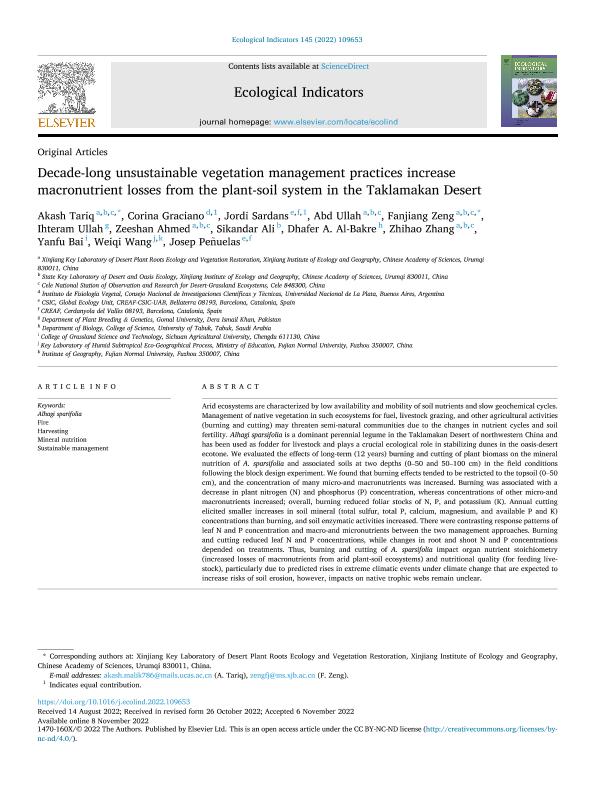Mostrar el registro sencillo del ítem
dc.contributor.author
Tariq, Akash
dc.contributor.author
Graciano, Corina

dc.contributor.author
Sardans, Jordi
dc.contributor.author
Ullah, Abd
dc.contributor.author
Zeng, Fanjiang
dc.contributor.author
Ullah, Ihteram
dc.contributor.author
Ahmed, Zeeshan
dc.contributor.author
Ali, Sikandar
dc.contributor.author
Al Bakre, Dhafer A.
dc.contributor.author
Zhang, Zhihao
dc.contributor.author
Bai, Yanfu
dc.contributor.author
Wang, Weiqi
dc.contributor.author
Peñuelas, Josep

dc.date.available
2023-08-29T13:17:13Z
dc.date.issued
2022-12
dc.identifier.citation
Tariq, Akash; Graciano, Corina; Sardans, Jordi; Ullah, Abd; Zeng, Fanjiang; et al.; Decade-long unsustainable vegetation management practices increase macronutrient losses from the plant-soil system in the Taklamakan Desert; Elsevier Science; Ecological Indicators; 145; 12-2022; 1-11
dc.identifier.issn
1470-160X
dc.identifier.uri
http://hdl.handle.net/11336/209691
dc.description.abstract
Arid ecosystems are characterized by low availability and mobility of soil nutrients and slow geochemical cycles. Management of native vegetation in such ecosystems for fuel, livestock grazing, and other agricultural activities (burning and cutting) may threaten semi-natural communities due to the changes in nutrient cycles and soil fertility. Alhagi sparsifolia is a dominant perennial legume in the Taklamakan Desert of northwestern China and has been used as fodder for livestock and plays a crucial ecological role in stabilizing dunes in the oasis-desert ecotone. We evaluated the effects of long-term (12 years) burning and cutting of plant biomass on the mineral nutrition of A. sparsifolia and associated soils at two depths (0–50 and 50–100 cm) in the field conditions following the block design experiment. We found that burning effects tended to be restricted to the topsoil (0–50 cm), and the concentration of many micro-and macronutrients was increased. Burning was associated with a decrease in plant nitrogen (N) and phosphorus (P) concentration, whereas concentrations of other micro-and macronutrients increased; overall, burning reduced foliar stocks of N, P, and potassium (K). Annual cutting elicited smaller increases in soil mineral (total sulfur, total P, calcium, magnesium, and available P and K) concentrations than burning, and soil enzymatic activities increased. There were contrasting response patterns of leaf N and P concentration and macro-and micronutrients between the two management approaches. Burning and cutting reduced leaf N and P concentrations, while changes in root and shoot N and P concentrations depended on treatments. Thus, burning and cutting of A. sparsifolia impact organ nutrient stoichiometry (increased losses of macronutrients from arid plant-soil ecosystems) and nutritional quality (for feeding livestock), particularly due to predicted rises in extreme climatic events under climate change that are expected to increase risks of soil erosion, however, impacts on native trophic webs remain unclear.
dc.format
application/pdf
dc.language.iso
eng
dc.publisher
Elsevier Science

dc.rights
info:eu-repo/semantics/openAccess
dc.rights.uri
https://creativecommons.org/licenses/by-nc-nd/2.5/ar/
dc.subject
ALHAGI SPARIFOLIA
dc.subject
FIRE
dc.subject
HARVESTING
dc.subject
MINERAL NUTRITION
dc.subject
SUSTAINABLE MANAGEMENT
dc.subject.classification
Agricultura

dc.subject.classification
Agricultura, Silvicultura y Pesca

dc.subject.classification
CIENCIAS AGRÍCOLAS

dc.subject.classification
Ecología

dc.subject.classification
Ciencias Biológicas

dc.subject.classification
CIENCIAS NATURALES Y EXACTAS

dc.title
Decade-long unsustainable vegetation management practices increase macronutrient losses from the plant-soil system in the Taklamakan Desert
dc.type
info:eu-repo/semantics/article
dc.type
info:ar-repo/semantics/artículo
dc.type
info:eu-repo/semantics/publishedVersion
dc.date.updated
2023-07-07T21:36:27Z
dc.journal.volume
145
dc.journal.pagination
1-11
dc.journal.pais
Países Bajos

dc.journal.ciudad
Amsterdam
dc.description.fil
Fil: Tariq, Akash. No especifíca;
dc.description.fil
Fil: Graciano, Corina. Consejo Nacional de Investigaciones Científicas y Técnicas. Centro Científico Tecnológico Conicet - La Plata. Instituto de Fisiología Vegetal. Universidad Nacional de La Plata. Facultad de Ciencias Naturales y Museo. Instituto de Fisiología Vegetal; Argentina
dc.description.fil
Fil: Sardans, Jordi. Consejo Superior de Investigaciones Científicas; España
dc.description.fil
Fil: Ullah, Abd. No especifíca;
dc.description.fil
Fil: Zeng, Fanjiang. No especifíca;
dc.description.fil
Fil: Ullah, Ihteram. No especifíca;
dc.description.fil
Fil: Ahmed, Zeeshan. No especifíca;
dc.description.fil
Fil: Ali, Sikandar. No especifíca;
dc.description.fil
Fil: Al Bakre, Dhafer A.. No especifíca;
dc.description.fil
Fil: Zhang, Zhihao. No especifíca;
dc.description.fil
Fil: Bai, Yanfu. No especifíca;
dc.description.fil
Fil: Wang, Weiqi. No especifíca;
dc.description.fil
Fil: Peñuelas, Josep. Consejo Superior de Investigaciones Científicas. Centre de Recerca Ecológica I Aplicacions Forestals; España
dc.journal.title
Ecological Indicators

dc.relation.alternativeid
info:eu-repo/semantics/altIdentifier/doi/http://dx.doi.org/10.1016/j.ecolind.2022.109653
Archivos asociados
